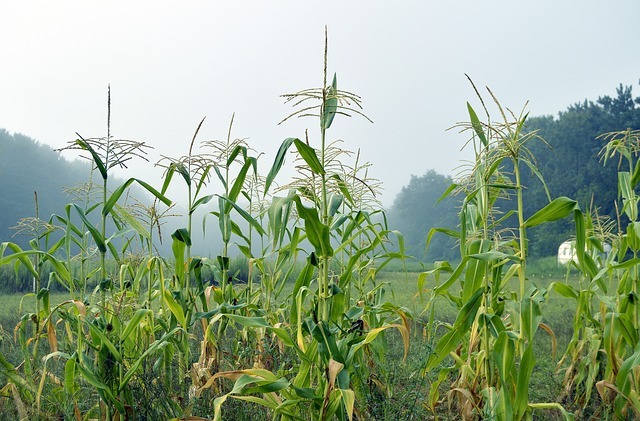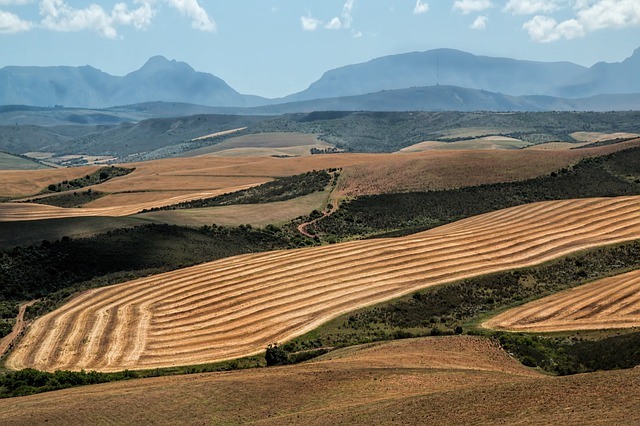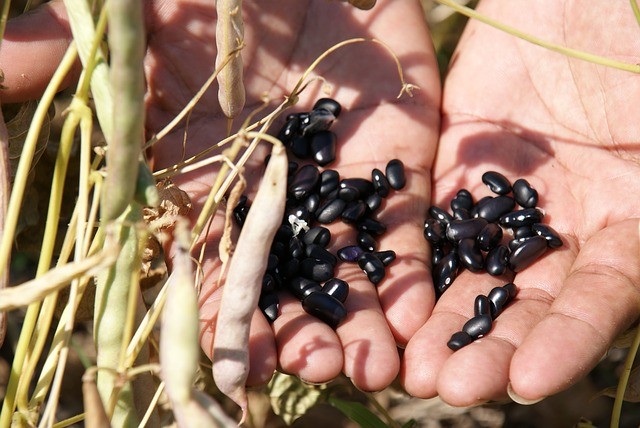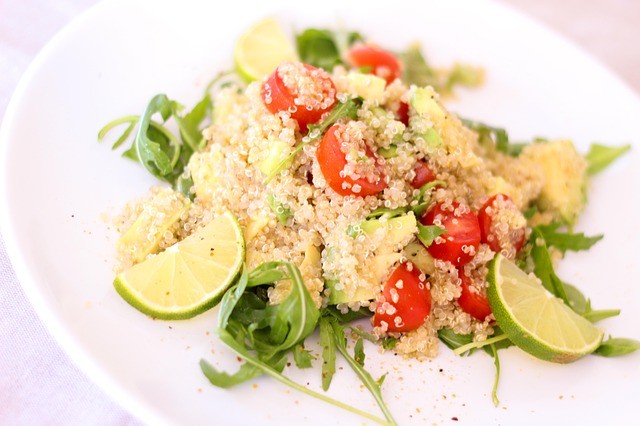Crops from the past might be the solution for the future

Corn Field image Quinn Kampschroer
Currently, four crop types comprise two-thirds of the world’s food supply. These are wheat, maize, rice, and soybean. When one looks at different countries and/or continents, one sees a big difference in the principal staple foods people consume.

Wheat Fields image Steve Buissinne
What do people eat
In Africa, the staple diet is made up of cereals (46%), roots and tubers (20%), and animal products (7%.)
In Western Europe, it is quite different: Animal products (33%), cereals (26%), and roots and tubers (4%.) Europeans are in general somehow healthy, but as they have turned away from natural foods, taking on the American lifestyle, health is in decline.
The fact that we eat so many animals is quite disturbing.
To feed all these animals, they cut trees down to provide meadows and agricultural land to grow the crops that feed these animals. Not such a good idea. It is a fact that all the crops which are used to feed animals could actually feed 4 billion people.
If we stop or eat considerably less meat, millions on millions of people worldwide would benefit from the product gained from the land not dedicated to feeding managed forage animals (cattle, sheep, pigs, etc.) This is definitely food for thought.
And of course, we have to consider the American staple diet, which seems to be even worse. Mainly man-made foods (highly processed foods), high in sugar, salt, and unhealthy fats. Having a modern health care system obviously does not make the population healthier, rather the contrary. Putting these 2 facts together it is a miracle we are still alive.

Soy Beans image Saicxi
A global research center in Malaysia
Malaysian scientists might have found the answer to a big problem. They are working in the headquarters of the global research center Crops for the Future (CFF). Investigating crops that were popular in the past and were cultivated for centuries but sadly have been abandoned and forgotten.
The Moringa trees are a good example. Its many health benefits are newly discovered. Then there are the Bambara groundnuts and the Kedondong berry.
These are just 3 examples of crops that are not well known outside the places where they are grown The 4 principal crops, maize, rice, wheat, and soybean are preferred leaving out the possibility to benefit from nature’s gift to humanity.
Let us not forget another aspect. The 4 main crops are heavily sprayed and genetically modified and because of the pesticide, herbicide, and GMO nature, pose a danger to our health.

Rice-Terraces image Public Domain Pictures
7000 forgotten crops
Prof Azam-Ali says that 7000 crops that were farmed for thousands of years are now being ignored in favor of the famous 4. With so many “forgotten” or infrequently used plants as a food source, one does not have to wonder why so many people have nothing to eat in this world.
The UN Food and Agriculture Organization tells us that the food sector is responsible for a third of global greenhouse gas emissions. High time to find some greener substitutes. It is estimated the population on our planet will balloon to over 10 billion people by the year 2050. What will be their food source and will they be able to grow this crop?
The agricultural output will have to increase by an additional 50%. Considering that so much is wasted in the industrial/rich countries, the time is more than ripe to seriously look for alternatives.
Forgotten crops are more climate change resilient
Prof Azam-Ali tells us that forgotten crops are more climate-resilient besides being more nutritious. The fact is that we (humans) should eat a variety of foods. Varying your diet and consuming a wide variety of different foods is much better for your health.
The news about these forgotten crops is so interesting. In one of the big domes of the CFF, food technologist Tan Xin Lin is experimenting with new ingredients, trying to make a combination that is appealing and good tasting.
Substitutes for wheat flour in the form of Moringa leaves can be used to bake a cake that is low in gluten but much higher in nutrients. She is making new recipe combinations that should appeal locally as well as to international taste buds.
Worldwide, the middle class is drawn to fast food as well as processed foods. This will have long-lasting effects on overall health rates. Children who grow up on hamburgers and fries suffer from obesity at a young age. Soft drinks also play a big part in making us sick.
Do not miss the following video on the Bambara Groundnut.
Quinoa becomes known
In colonial times, the locals planted and harvested the Bambara groundnut. It is a protein-rich legume and was eaten in sub-Saharan Africa and certain parts of southeast Asia. At the time, women who cultivated the Bambara groundnut were punished for doing so. The colonial powers did not see a market for it because it lacked oil.
Nowadays the CFF is very optimistic as the Bambara groundnut is one of their favorite crops. This is similar to the rise of the awareness and consumption of quinoa 30 years ago. CFF thinks investors will see the potential of betting on this new crop.

Quinoa dish image Bernadette Wurzinger
Can crops adapt to climate change?
Scientists are experimenting with these new plants, taking climate change very much into account. These crops should be able to thrive in warmer climates. CFF is the world’s first research center dedicated solely to underutilized crops. There are other companies that focus their attention on agricultural diversity, like Bioversity International.
They operate together with partners in low-income countries. They try to improve agriculture and tree biodiversity for the people hoping for better nutrition, more production, and helping them to adapt to climate change. Crop Trust, Slow Food, and ICRISAT are some other companies with a similar focus.
Save our agricultural inheritance to provide food for the future
If we do not revive these forgotten crops, used by our ancestors for 10,000 years, we might lose the knowledge of how to plant, harvest, and use them within a single generation. They might present the solution for the future when the famous 4, maize, rice, soybeans, and wheat could struggle to survive the imminent effects of climate change.
I am happy there are so many people trying to provide food for coming generations, healthy food and locally grown.
An afterthought
These days I saw a video that shows the sins we commit to our environment. Earlier I said these crops will be Climate Change Resilient. With the information from this video, I think that statement is not correct. The temperature will rise more than we expect, so even these crops might not survive. I hope you will also look at this video.
Before you leave, pay a visit to the page Recommendations. I have made a collection of things you might find interesting.
Source: BBC Future 22 August 2018 article by Preeti Jha
Photo Source: Pixabay
Perhaps you like to read my post on Fast Food











Comments
Netta
Hey Taetske:
Thank you for this very informative post about forgotten food crops. It’s a mind-boggle that there are 7,000 kinds of food that could be added to the major four to help to feed us all.
It is a wonderful thing that they are being rediscovered and that interest is high to find ways to use these foods in modern times.
I am noticing that the collaboration between the researchers, farmers and cooks is producing a lot of exciting new things for us foodies to try.
New plants that can thrive where the big four don’t, new sources for nutritional values that are not available from the four and for people who have developed allergies, new tastes for those who love food….all good things.
Taetske
Good Morning Netta,
Thank you for your comment on my post about the forgotten crops. When I came across this news I was all happy as normally the news we hear every day is sad and or negative. When one thinks of how many million people go hungry every day the rediscovery of these forgotten crops gives hope. Hopefully, more scientists worldwide will join this effort in Malaysia to make these crops known to everybody. Then we can all enjoy healthy new foods which are not sprayed and neither have been manipulated.
Regards, Taetske
Victor
This post was so telling, I do agree that people in the U.S. eat way too much processed foods but I do have to say that I love meat. My wife has been trying to cut down on meat and animal products and she even went as far as to being vegan for a couple of weeks. I think I’m just accustomed to my way of eating but I will say that I am trying to cut down on it. Quinoa is such a great food, it keeps you full and tastes great when seasoned.
Taetske
Good afternoon Victor,
To eat meat now and then is perfectly ok but it should be meat from a happy cow. A happy cow gets healthy food and lives a good life mainly on a clean meadow. Like that you will get good meat which is free from GMO, pesticides, hormones etc.
It is very important for our health what we put into our body. I am 68 now and feeling fine. I plan on feeling fine for many years to come and I hope you will do too.
Thank you for visiting my website, I hope to see you again.
Regards, Taetske
Tabsmark
What an interesting read, how sad that good food has been forgotten about. I was very interested in the idea of cooking and baking with other alternatives like Moringa Leaves. We have quite a bit of moringa powder in our local supermarket in Victoria Falls Town. I have often wondered what you could use it for. Maybe I will try a bit of experimenting with baking a cake with it. Would you know where you could obtain moringa powder online?
Taetske
Good afternoon, a shame I do not know your name,
Thank you for leaving a comment on my post. I have seen that Amazon has different brands of Moringa powder.
I will also send you a link to a UK based company which also delivers to European countries. I think there is a big choice.
Now you can compare prices with your local market. Good luck with your baking experiment.
Regards, Taetske
< https://www.bulkpowders.co.uk/organic-moringa-powder.html
Glen
One issue with using forgotten crops is keeping supply up with demand. It takes time to plan, plant, grow, and harvest new food crops. The question then are existing sources like quinoa sustainable as demand increases. The Peruvian fruit Lucuma, called the Gold of the Incas, is gaining popularity as word gets out. Can existing sources handle increasing demand or will new plantings keep up with demand?
Taetske
Good Morning Glen,
Thank you for visiting my website.
Forgotten crops could very well be the answer to having a great lack of healthy foods. The 4 known crops do not have the same nutrient values anymore as they did in the past. We are eating GMO, pesticides etc which are then made into foods where more nasty things are added like too much sugar, bad fats, artificial colors, bad salt, and the list goes on.
I do not think we have to worry as normally, when earning money is involved, ways are found to keep supplies up.
You mention the Lucuma fruit. It seems to be a good substitute for sugar. It has different Bs, C, and Minerals and is said to be good against inflammation, for cardiovascular health, blood sugar and various more things. I will keep an eye out for this fruit on our local market but have not seen it up till now.
Regards, Taetske
Chris
Hey Taetske!
This was a very informative post! It is so sad to see so many people eating highly processed foods and foods high in sugar! I myself have recently started eating more natural and trying to become more health conscious!
Overall I have seen a huge boost in my energy levels! Also it is crazy to see that there are 7000 forgotten crops! I never would have guessed! Would by chance have a list of these crops somewhere?!
All the Best,
Chris
Taetske
Good afternoon Chris,
Thank you for your comment on my post.
The more you eat natural things and keep away from man-made foods the better you will feel. In the long term your overall health will improve so it is well worthwhile.
I am sending you a link of which I hope it will answer your question. It is quite a bone to chew on.
Regards, Taetske
< https://www.the-scientist.com/news/out-of-africa-a-database-of-7000-useful-plants-52454
Emmanuel Buysse
This is a very great article, personally I never knew there was so many food adding to those crops who feeds us.
But what is indeed really bad, and people in Europe are starting to realize it, meat is causing lots of problems, a single cow produces as much as a car of co2 in a year. Look how many cows there are, and how much land they take.
This is a major problem, I really hope the world see this before it is too late.
Being a vegetable isn’t bad, even if we would onmy eat meat once per week, lots would be different.
Do you think the humanity will change his mind before it is too late, and turn his head into those crops that can safe not only us, but later generations?
Thanks for sharing this post with us!
Taetske
Good afternoon Emmanuel,
Thank you for your comment on my post. I am sending you a link where you can read about cows/humans. It is a good idea to reduce eating meat to once a week. Take care it is the meat of happy cows, like organic.
Otherwise you fill up on GMO, pesticides, hormones etc. Definitely not good for your health. I also hope people will wake up before it is too late, time is running short.
Regards, Taetske
https://motherearthstreasures.com/greenhouse-gas-from-permafrost-set-free-in-the-arctic
Scott Hinkle
Thanks for the interesting article! I never gave crops of the past much thought. I just assumed they gave way to ones that were easier to cultivate and had wider uses. It’s nice to know someone is thinking of the future while looking into the past. I wonder what nutritional benefits we’re missing that were not an issue back in the day.
My several concerns, regarding adoption… Number one on my list is taste. I read that a cake can be made from some of these crops but how does it taste? My second concern is the powers that be. An example would be the beef industry. Everyone wants to protect their bottom line and the consequences (health, resources, etc.) are secondary to that bottom line. Don’t get me wrong, I love meat and that takes me to the next concern, adoption. I don’t see change happening over-night. I expect there will be push-back in the forms of “eww that’s gross” and fear tactics like “what do we really know about new food x” and so on. That’s going to be a very big hurdle.
I found it interesting that the crops we use to feed animals for consumption could, themselves, feed 4 billion people. That’s just staggering. With so much food waste in developed countries and sizeable crops being used to feed animals vs people directly, it’s just a sad situation and that’s not even taking into account animal rights and what not.
Thank you again for this post. It’s definitely food for thought.
Taetske
Good Morning Scott,
Thank you for leaving a comment on my website.
I think it is Monsanto who has been responsible in dictating farmers what crops to plant to then also be able to sell their infamous Roundup. It is set up to make them earn money at the cost of our health. That the modern crops are highly contaminated really is of no concern to Monsanto.
I think that peoples taste buds adapt easily to new things most of the times it is unhealthy. Advertisements have been capable of fooling our eyes to then change our shopping habits. We come home with artificial stuff which looks pretty and harms our health. We are an easy adaptable species.
We waste too much food while people elsewhere go hungry, it is a scandal. We treat animals in the foulest way which is another serious problem. The human race has not evolved yet to the point of understanding that all these sins have consequences.
Regards, Taetske
Scott Hinkle
I agree and I’m now going to start looking at my options. I’ll be totally honest, I’m still going to lean toward what tastes good but, I don’t know what a lot of the old grains taste like nor how to prepare them so, I’m looking forward to seeing what can be done.
Taetske
Good evening Scott,
Thank you for leaving a comment on my post. I have eaten a couple of old grains like Spelt. I can tell you it tastes very good. A bread made with this grain stands far above the bland white bread made of wheat. I really would give it a try. We have been able to adapt our taste over the thousands of years of food evolution. Therefore I do not think it will be too difficult to adapt to the taste of new grains, fruits, and vegetables.
I was used to butter and on coming to Spain I switched over to virgin olive oil, a big difference in taste. I am not worried at all. Walking over the weekly market every now and then a new edible is presented, so it is in constant flux.
Regards, Taetske
HappyB
Hi Taetske
Fascinating that there are so many “forgotten” crops. I wonder if there is a list somewhere?
I must admit, I had a bit of fun figuring out how to cook Quinoa and integrate it with other foods. Like you say, there is a lot of knowledge going to be lost if we do not get a handle on these other possible food sources.
I did a bit of research on Moringa as well. It is fascinating and yet not well known.
There is obviously a lot todo to discover these forgotten crops and start facing up to the terror of climate change and its consequences.
Taetske
Good afternoon,
I would have liked to be able to talk to you using your name, perhaps next time.
I found an article with a lot of information, I am sending you the link, have a look..
I personally love Quinoa, I think it goes well with chicken curry.
Thank you for visiting my website, hope to see you again.
Regards, Taetske
https://www.the-scientist.com/news/out-of-africa-a-database-of-7000-useful-plants-52454
A Jaynes
This was a very insightful read, thank you. I’ll be the first to admit – this is not a topic I’ve come across before, nor one I had given any thought towards. It is very fascinating to think about the possibilities in keeping the “famous 4” alive and helping us thrive through different solutions. I think progress with food development is something that we don’t spend enough money researching in the 21st century when the reality is, it just might be one of the most important things we ever did.
Taetske
Good Morning,
When one finds out that our excessive meat consumption means 4 billion people have hardly any food to survive it does make you think, don’t you agree? If the resources available to us were better managed and distributed, a lot of things would look different on our earth.
There is the big “problem” of refugees worldwide. People who have no future in their country of birth and want a better future for themselves and their children. They say money is the root of all evil and one can see it everywhere. The greed of a few makes life miserable for many.
If the basics are guaranteed, a roof over your head and a job, food on the table, education and healthcare, then most people like to stay in their own country. Then people will feel no need to wander the world searching for a better place. The rediscovery of the 7000 forgotten crops forms an important part for that to happen.
Thank you for your comment. I hope you downloaded the free PDF of your choice? Tulip widget.
Regards, Taetske